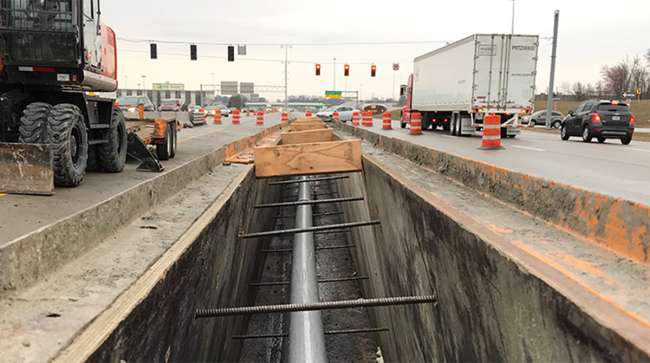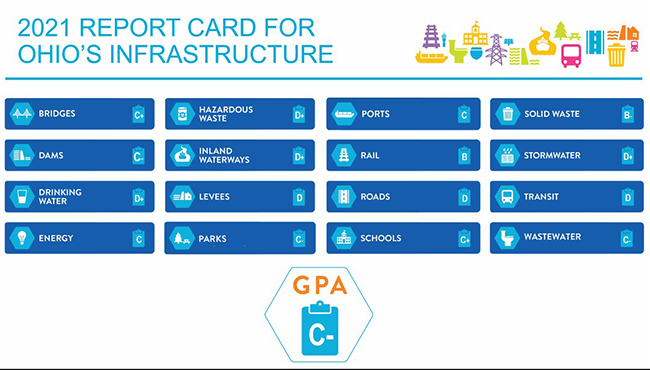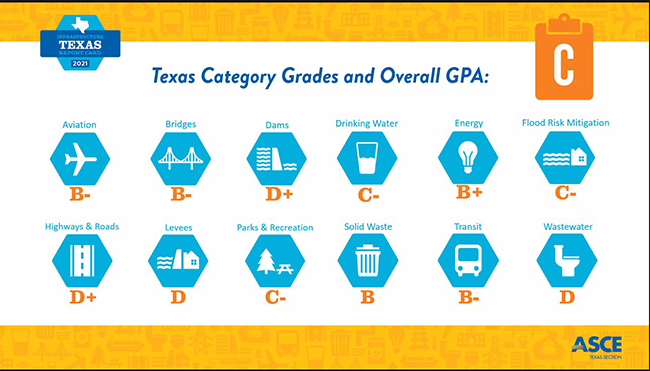Staff Reporter
Texas, Ohio Earn Mediocre Infrastructure Grades From ASCE

[Stay on top of transportation news: Get TTNews in your inbox.]
Texas and Ohio, which serve as important freight hubs, earned mediocre grades on the infrastructure report cards recently issued by the American Society of Civil Engineers.
Texas earned a C on its report card, the results of which were announced Feb. 10. (Texas’ full report card is scheduled to be released in late February.) The report card evaluated 12 categories of infrastructure: aviation, bridges, dams, drinking water, energy, flood risk mitigation, levees, public parks and recreation, highways and roads, solid waste, transit and wastewater.
Ohio fared slightly worse, earning an overall C- on its report card, unveiled Feb. 11. Ohio’s report card analyzed 16 classes of infrastructure: bridges, dams, drinking water, energy, hazardous waste, inland waterways, levees, parks, ports, rail, roads, schools, solid waste, stormwater, transit and wastewater.

The results indicated road infrastructure is a challenge in both states. Texas’ highways and roads earned a D+. ASCE representatives said congestion on roadways is a significant and costly challenge in Texas, particularly in the Austin, Dallas and Houston areas. Mark Boyd, chairman of Texas’ infrastructure report card committee, said the average Texas auto commuter spends 54 hours in traffic annually.
Austin Messerli, chairman of the Texas section’s highways and roads subcommittee, said these travel delays impact freight haulers as well as regular commuters. Messerli identified maintenance of pavement conditions and road widening efforts as improvements that can benefit the trucking industry.
“It can come from a few different angles,” Messerli said. “The infrastructure challenges on roads and highways definitely impact the truck movement through Texas.”
Ohio’s roads earned a D, tying with transit and levees for poorest grade on the report card. Lloyd MacAdam, chief engineer of the Ohio Department of Transportation, described truck traffic as “a majorly important issue” for Ohio. State transportation officials and members of Congress spoke at Ohio’s event, along with ASCE representatives.

MacAdam said 34% of the truck traffic in Ohio drives straight through the state. At ODOT, MacAdam said the agency has concentrated on improving freight “pinch points,” such as the interchange between interstates 70 and 71 in Columbus. He also said the agency tries to make sure truckers have adequate facilities, such as parking spaces.
“Infrastructure is the lifeblood of our economy,” MacAdam said. “It’s how goods get to manufacturing plants and stores. Unlike wine, infrastructure does not get better with age.”
One significant challenge in Ohio is the negative effect the COVID-19 pandemic has had on funding levels. James Pajk, past president and current treasurer of ASCE’s Ohio Council of Sections, noted that, despite increased motor fuel tax rates established in 2019, revenue has fallen short of original projections because fewer people have been driving during the pandemic. The Ohio Council was organized in 1969 and represents the six local ASCE sections situated in the state.
The grades are in! The Buckeye State receives a "C-" in the 2021 Report Card for Ohio's Infrastructure pic.twitter.com/vsvGfUYLiY — ASCE Gov't Relations (@ASCEGovRel) February 11, 2021
MacAdam said passenger vehicle traffic has yet to climb back to 2019 levels. However, between June 2020 and early February, he said truck traffic was up significantly in Ohio. MacAdam said this is partly because more people are buying goods online and having them delivered to their homes. From March to November, gas tax revenues for ODOT have been down about $198 million from originally anticipated levels. Without the 2019 fuel tax increase, MacAdam said this funding gap would have been much worse.
In Texas, one major challenge is an increasing population. According to the U.S. Census Bureau, Texas had a population of 28.9 million people in July 2019. Boyd, who also works as an adjunct professor of engineering at Southern Methodist University, said Texas is growing by about 1,000 individuals per day.
“No one is unpacking water, sewer or roadway systems from their luggage as they arrive,” Boyd said.
ASCE’s national report card is scheduled to be released March 3. ASCE President Jean-Louis Briaud, who also works as an engineering professor at Texas A&M University, said ASCE has asked Congress to consider certain priorities, such as sustainable and resilient infrastructure.
Today, @TEXASCEtweets revealed findings from their 2021 Texas Infrastructure Report Card. Learn more!https://t.co/mnxNM4IHqT — ASCE Gov't Relations (@ASCEGovRel) February 10, 2021
President Joe Biden has not yet unveiled the details of his infrastructure plan, which is expected to total about $2 trillion.
“The president’s desire to see results on infrastructure provides a real opportunity in 2021 to make significant progress toward modernizing our nation’s built systems,” Briaud said.
Want more news? Listen to today's daily briefing below or go here for more info:

